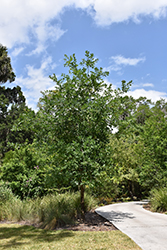Fri & Sat 8am - 8pm
Sun 8am - 7pm
Anytown, USA 12345
fax: 261.787.0463
e-mail: info@successgc.com


Plant Finder

Height: 50 feet
Spread: 40 feet
Sunlight:
![]()
Hardiness Zone: 8a
Other Names: Bastard White Oak
Description:
This smaller variety of oak makes an excellent shade tree, with an upright spreading habit and rounded, open crown; native to warm southern or coastal areas; perfect for larger home landscapes; heat and drought tolerant; rather slow growing
Ornamental Features
Bluff Oak has dark green deciduous foliage which emerges grayish green in spring on a tree with a round habit of growth. The glossy lobed leaves turn outstanding shades of gold, orange and coppery-bronze in the fall. However, the fruit can be messy in the landscape and may require occasional clean-up. The furrowed gray bark adds an interesting dimension to the landscape.
Landscape Attributes
Bluff Oak is a dense deciduous tree with a more or less rounded form. Its average texture blends into the landscape, but can be balanced by one or two finer or coarser trees or shrubs for an effective composition.
This tree will require occasional maintenance and upkeep, and is best pruned in late winter once the threat of extreme cold has passed. It is a good choice for attracting butterflies and squirrels to your yard. Gardeners should be aware of the following characteristic(s) that may warrant special consideration;
- Messy
Bluff Oak is recommended for the following landscape applications;
- Accent
- Shade
Planting & Growing
Bluff Oak will grow to be about 50 feet tall at maturity, with a spread of 40 feet. It has a high canopy with a typical clearance of 6 feet from the ground, and should not be planted underneath power lines. As it matures, the lower branches of this tree can be strategically removed to create a high enough canopy to support unobstructed human traffic underneath. It grows at a slow rate, and under ideal conditions can be expected to live to a ripe old age of 300 years or more; think of this as a heritage tree for future generations!
This tree should only be grown in full sunlight. It is very adaptable to both dry and moist locations, and should do just fine under average home landscape conditions. It is considered to be drought-tolerant, and thus makes an ideal choice for xeriscaping or the moisture-conserving landscape. This plant will benefit from an application of bonemeal and/or mycorrhizal fertilizer at the time of planting. It is not particular as to soil type, but has a definite preference for acidic soils, and is subject to chlorosis (yellowing) of the foliage in alkaline soils. It is somewhat tolerant of urban pollution. This species is native to parts of North America.
